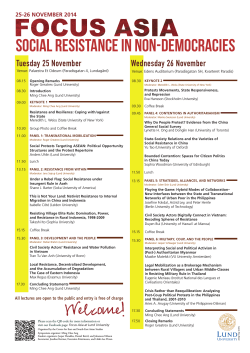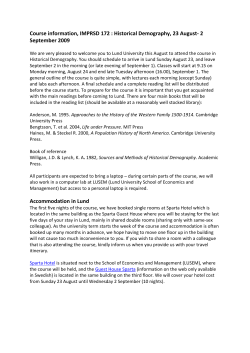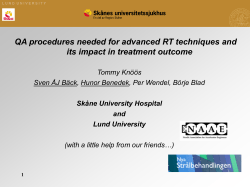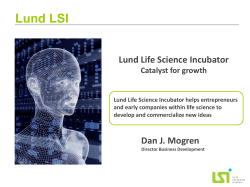
Physics, Nanoscience fact sheet
LUND UNIVERSITY | SWEDEN | FACULTY OF SCIENCE | DEPARTMENT OF PHYSICS Master’s Programme in Physics – Nanoscience •Master of Science in Physics •2 years, full time, 120 ECTS credits •Department of Physics •Lund Campus •Application deadline: 15 January 2015 •Programme start: August 2015 Programme overview Admission requirements and how to apply ADMISSION REQUIREMENTS A BSc in Physics or Nanoscience or an equivalent BSc corresponding to at least three years of study in science or engineering. Courses in physics of at least 40 higher education credits and mathematics of at least 40 higher education credits must be included. These courses should cover basic quantum mechanics, electromagnetism, solid state physics, On the nanometre scale, the distinction between disciplines multi-dimensional calculus, linear algebra and Fourier analy- such as physics, chemistry and biology becomes less clear. sis. English 6/English Course B See www.lunduniversity.lu.se Characteristic for nanotechnology is therefore a high degree for details on English proficiency levels. of interdisciplinarity. The Nanoscience programme at Lund University has its scientific base in a physics description of nanoscale phenomena, but in addition to nanophysics you can, depending on your background and interests, choose to specialise in fields such as nanoelectronics, materials science or biophysics. The programme is part of the Nanometer Structure Consortium, one of the world’s leading nanoscience research centres. You will interact with cutting-edge research throughout the programme, starting in the first semester and building up to the Master’s project. Moreover, by taking advantage of the wealth of courses offered by Lund HOW TO APPLY 1. Go to www.lunduniversity.lu.se and find the programme. Click on “Apply” and follow the instructions for the online application form on the Swedish national application website. 2. Send your supporting documents (for details on docu- ment requirements, see www.universityadmissions.se): - Cover sheet - Certificates and diplomas from previous studies at an inter nationally recognised higher education institution (univ- University, you will be able to explore the cross-disciplinary nature of nanoscience. Programme modules/courses COMPULSORY COURSES AND NUMBER OF CREDITS: Semiconductor Physics (7.5), Processing and Device Technology (7.5), Materials Analysis at the Nanoscale (7.5), The Physics of Low-Dimensional Structures and Quantum Devices (7.5), Master’s degree project (30). ELECTIVES: Choose elective courses for specialisations in, for example nanophysics, materials science or biosensors. Full list of courses can be found at http://www.edu.physics.lu.se/masters/nanoscience. Career prospects There is an increasing demand worldwide for people knowledgeable in nanotechnology. Nanoscientists are not only needed in specialised nanotechnology companies but also in more traditional industries, with more and more nanotechnology being incorporated into products. Thanks to the close connection to world-class research, the Master’s programme also provides excellent preparation for doctoral studies and an academic career. What students say “The programme is highly interdisciplinary. Depending on what field you decide to focus on within this Master’s programme in Nanoscience you can pursue what you really want to do in your future career, which is great.” Sudhakar Sivakumar, from India t - Transcripts of completed courses and grades for each se- About Lund University Lund University was founded in 1666 and for a number of mester (including course list) years has been ranked among the world’s top 100 univer- - Proof of English language skills sities. The University has 47 700 students and 7 500 staff - Statement of purpose based in Lund, Helsingborg and Malmö. We are united in - Letters of recommedation our efforts to understand, explain and improve our world - Proof that you meet the specific admission requirements and the human condition. - Copy of the page in your passport with your personal data and photograph, or some other identification document Lund is Sweden’s most attractive study destination. The Uni- (EU/EEA citizens may need to send a certified passport versity offers one of the broadest ranges of programmes copy) and courses in Scandinavia, based on cross-disciplinary and 3. Make sure to check the country specific requirements on cutting-edge research. The compact university campus en- www.universityadmissions.se before sending your docu- courages networking and creates the conditions for scien- ments. tific breakthroughs and innovations. The University has a 4. Pay the application fee (when applicable). clear international profile, with partner universities in over 50 countries. SELECTION CRITERIA/ADDITIONAL INFO Selection of students is based on previous univer- Funding of SEK 5 billion a year goes to research at eight fac- sity/college studies and other merits such as letters of ulties, which gives us one of Sweden’s strongest and broad- recommendation and statement of purpose. est ranges of research activity. Over 30 of our research fields are world-leading, according to independent evaluations. TUITION FEES There are no tuition fees for EU/EEA citizens. For non-EU/EEA citizens the tuition fee for this programme is SEK 140 000 per year. For details on tuition fees, see www.lunduniversity. lu.se. About the Department of Physics The Departments of Physics has over 300 researchers, teachers, technicians and administrators. We work to extend the understanding of physics and its applications, and to communicate our findings, and those of others, to new generations. We also teach the basics of physics to over one thousand students every year. CONTACT Programme webpage www.lunduniversity.lu.se/Physics-Nano Study advisor Dan Hessman, Dan.Hessman@ftf.lth.se Johan Zetterberg, Johan.Zetterberg@fysik.lu.se Tomas Brage, Tomas.Brage@fysik.lu.se Disclaimer: Changes may have been made since the printing of this fact sheet. Please see www.lunduniversity.lu.se for any updates. ersity or university college)
© Copyright 2025





















